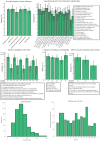A Psychometric Platform to Collect Somatosensory Sensations for Neuroprosthetic Use
- PMID: 35047903
- PMCID: PMC8757828
- DOI: 10.3389/fmedt.2021.619280
A Psychometric Platform to Collect Somatosensory Sensations for Neuroprosthetic Use
Erratum in
-
Corrigendum: A Psychometric Platform to Collect Somatosensory Sensations for Neuroprosthetic Use.Front Med Technol. 2022 Feb 24;4:866538. doi: 10.3389/fmedt.2022.866538. eCollection 2022. Front Med Technol. 2022. PMID: 35281670 Free PMC article.
Abstract
Somatosensory neuroprostheses exploit invasive and non-invasive feedback technologies to restore sensorimotor functions lost to disease or trauma. These devices use electrical stimulation to communicate sensory information to the brain. A sensation characterization procedure is thus necessary to determine the appropriate stimulation parameters and to establish a clear personalized map of the sensations that can be restored. Several questionnaires have been described in the literature to collect the quality, type, location, and intensity of the evoked sensations, but there is still no standard psychometric platform. Here, we propose a new psychometric system containing previously validated questionnaires on evoked sensations, which can be applied to any kind of somatosensory neuroprosthesis. The platform collects stimulation parameters used to elicit sensations and records subjects' percepts in terms of sensation location, type, quality, perceptual threshold, and intensity. It further collects data using standardized assessment questionnaires and scales, performs measurements over time, and collects phantom limb pain syndrome data. The psychometric platform is user-friendly and provides clinicians with all the information needed to assess the sensory feedback. The psychometric platform was validated with three trans-radial amputees. The platform was used to assess intraneural sensory feedback provided through implanted peripheral nerve interfaces. The proposed platform could act as a new standardized assessment toolbox to homogenize the reporting of results obtained with different technologies in the field of somatosensory neuroprosthetics.
Keywords: amputees; electrodes; neuroprosthesis; neurostimulation; platform; psychophysics; sensory feedback; somatosensations.
Copyright © 2021 Valle, Iberite, Strauss, D'Anna, Granata, Di Iorio, Stieglitz, Raspopovic, Petrini, Rossini and Micera.
Conflict of interest statement
FP, SR, and SM hold shares of Sensars Neuroprosthetics Sarl, a start-up company dealing with potential commercialization of neurocontrolled artificial limbs. The remaining authors declare that the research was conducted in the absence of any commercial or financial relationships that could be construed as a potential conflict of interest.
Figures





References
LinkOut - more resources
Full Text Sources

